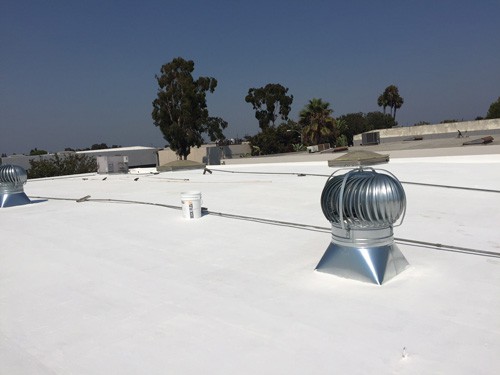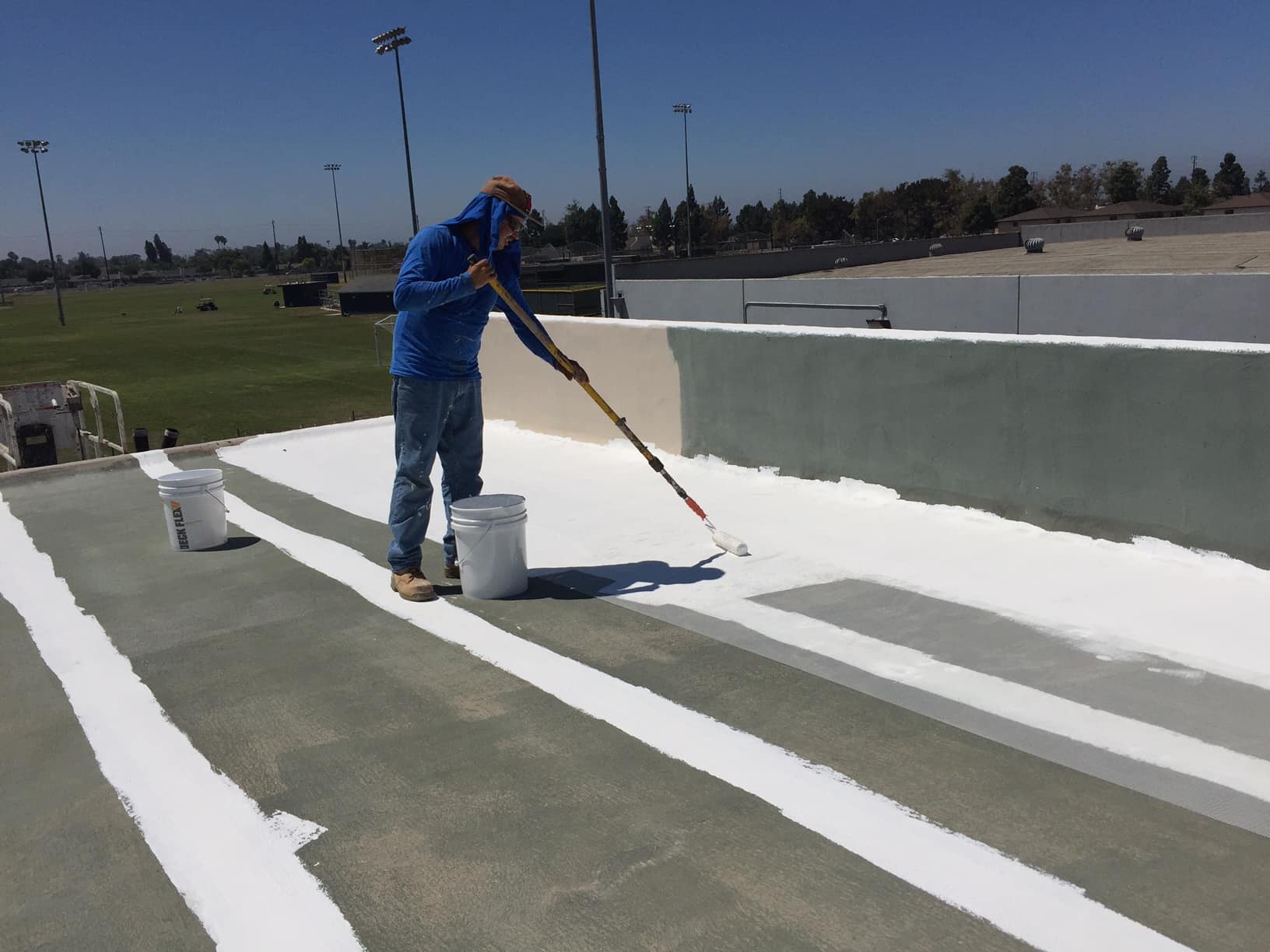Deck Flex's Elastomeric Roof Coating is easy-to-apply and will protect and beautify your roof surfaces. In this guide we cover surface preparation, application and maintenance basics. In addition to the step-by-step guide below, we published a short ~3min video on YouTube that goes a little deeper beyond the basics.
How to Apply Deck Flex Elastomeric Roof Coating
Professional application guide for long-lasting roof protection
What is Elastomeric Roof Coating?
Elastomeric roof coatings are high-performance, rubber-like materials that provide superior protection for various roofing substrates. According to the U.S. Department of Energy, these cool roof coatings can reflect solar energy and reduce cooling costs by up to 15%.
The unique elastomeric properties allow the coating to expand and contract with temperature fluctuations without cracking, making it ideal for climates with extreme weather variations. Learn more about elastomeric coating benefits and how they compare to traditional roofing solutions. For expert elastomeric roof coating recommendations, our technical team can help you select the right product for your specific application.
Suitable Roof Types for Elastomeric Coating
Metal Roofs
Excellent adhesion to galvanized steel, aluminum, and other metal substrates. Prevents rust and corrosion while providing UV protection.
Concrete & Masonry
Seals porous concrete surfaces, preventing water infiltration and freeze-thaw damage common in colder climates.
Built-Up Roofing (BUR)
Restores and extends the life of aging built-up tar and gravel roofs without costly tear-off and replacement.
Single-Ply Membranes
Compatible with EPDM, TPO, and PVC membranes, adding an extra layer of protection and reflectivity.
Note: Always check with the National Roofing Contractors Association or your local building codes for specific requirements in your area.
Tools & Equipment
- Pressure Washer
- Broom
- Industrial Paint Brush or Roller (roller recommended for larger surfaces)
- Deck Flex Elastomeric Roof Coating
Benefits of Elastomeric Roof Coatings
Waterproofing Protection
Creates a seamless, flexible membrane that prevents water infiltration and protects against leaks. The elastomeric properties ensure complete coverage without seams or joints where water can penetrate.
UV & Heat Reflection
Reflects up to 90% of UV rays, reducing cooling costs and extending roof life. The highly reflective surface keeps buildings cooler in summer, lowering energy bills and improving interior comfort.
Flexibility & Durability
Expands and contracts with temperature changes without cracking or peeling. This flexibility allows the coating to accommodate building movement and thermal expansion cycles that would damage traditional roof coatings.
Cost-Effective Solution
Extends roof life by 10-15 years while reducing energy costs and maintenance needs. The initial investment pays for itself through avoided roof replacement costs and ongoing energy savings.
Step-by-Step Application Process
- Step 1: Prepare Surface
- Step 2: Pressure Wash Surface
- Step 3: Let Dry (72 Hours)
- Step 4: Mask Around Edges
- Step 5: Apply Elastomeric Coating (Coverage rate: 100-200 sq ft per gallon, Drying time: 1-4 hours, Recoat time: 24-48 hours)
- Step 6: Recoat Roof Surface


Learn more about what elastomeric coatings are and how they work.
Important Application Tips
- Check weather forecast before starting - avoid application if rain is expected within 24 hours
- Always wear appropriate safety equipment including gloves, eye protection, and non-slip footwear
- Store coating materials properly and dispose of waste according to local regulations
- Keep detailed records of application including product used, coverage rate, and date applied
Maintenance & Care
To maximize the lifespan of your elastomeric roof coating, perform regular maintenance inspections at least twice per year. Remove debris, clean drainage areas, and inspect for any signs of wear or damage. Address minor issues promptly to prevent larger problems. The EPA recommends proper roof maintenance to prevent water damage and improve building efficiency.
With proper application and regular maintenance, Deck Flex elastomeric roof coatings can provide 10-15 years of reliable protection. Plan for recoating when you notice signs of wear, typically after 10-12 years depending on climate conditions and roof traffic. For additional protective solutions, explore our All-Purpose Protective Sealer for other surfaces.
Common Mistakes to Avoid
Inadequate Surface Preparation
Skipping proper cleaning and preparation is the #1 cause of coating failure. Always thoroughly clean and dry the surface before application. Moisture trapped under the coating will cause blistering and peeling.
Applying in Wrong Weather Conditions
Applying elastomeric coating when rain is forecast, in extreme heat, or when temperatures are outside the recommended range (50-90°F) will compromise adhesion and curing. Check the National Weather Service forecast before starting.
Coating Too Thin or Too Thick
Not following manufacturer specifications for thickness will reduce performance. Too thin provides inadequate protection; too thick causes cracking and extended cure times. Use proper application tools and techniques.
Skipping the Second Coat
A single coat rarely provides adequate protection. Most elastomeric coatings require two coats for full performance. For complete waterproofing, consider our W.M. Waterproofing System.
Ignoring Safety Protocols
Working on roofs is inherently dangerous. Always use proper fall protection, wear appropriate safety gear, and follow OSHA guidelines. Never work alone or in adverse weather conditions.
Frequently Asked Questions
How long does elastomeric roof coating last?
With proper application and maintenance, elastomeric roof coatings typically last 10-15 years. Climate, roof traffic, and maintenance frequency all affect longevity. Regular inspections and prompt repairs extend the coating's life.
Can I apply elastomeric coating over existing coating?
Yes, in most cases you can recoat an existing elastomeric coating if it's still in good condition. The surface must be clean, dry, and free of loose or failing material. If the existing coating is severely degraded, complete removal may be necessary.
How much does elastomeric coating cost per square foot?
Material costs typically range from $0.50-$1.50 per square foot depending on the product and number of coats. Professional installation adds $2-$4 per square foot. DIY application with Deck Flex products can save significantly on labor costs.
What's the difference between elastomeric coating and paint?
Elastomeric coatings are much thicker (10-20 mils vs 2-4 mils for paint) and contain rubber-like polymers that allow them to stretch and contract. They provide superior waterproofing, crack-bridging, and durability compared to standard roof paint. Learn more about choosing the right coating.
Do I need to prime before applying elastomeric coating?
Priming depends on your roof substrate. Porous surfaces like concrete, wood, and unpainted metal typically require primer. Previously painted or coated surfaces may not. Always check the manufacturer's specifications or contact our team for guidance.
Can elastomeric coating stop an existing leak?
Elastomeric coating can seal minor cracks and prevent future leaks, but active leaks should be properly repaired first. Identify and fix the source of water infiltration, allow the area to dry completely, then apply the coating. For severe damage, consider our comprehensive waterproofing systems.
Related Guides
How to Seal Your Wood Deck
Learn the best practices for sealing and protecting your wood deck to ensure long-lasting beauty and performance.
Read GuideHow to Choose a Deck Coating Product
Expert advice on selecting the right deck coating product for your specific needs and climate conditions.
Read GuideRequest Information
Get expert advice on walking deck & roof covering waterproofing options.
